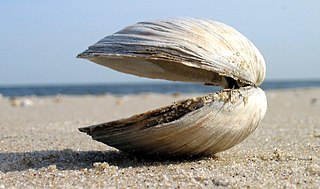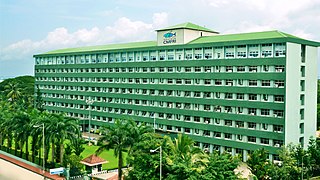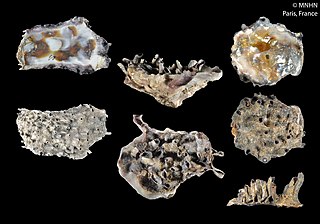
Mariculture or marine farming is a specialized branch of aquaculture involving the cultivation of marine organisms for food and other animal products, in enclosed sections of the open ocean, fish farms built on littoral waters, or in artificial tanks, ponds or raceways which are filled with seawater. An example of the latter is the farming of marine fish, including finfish and shellfish like prawns, or oysters and seaweed in saltwater ponds. Non-food products produced by mariculture include: fish meal, nutrient agar, jewellery, and cosmetics.

Shellfish is a colloquial and fisheries term for exoskeleton-bearing aquatic invertebrates used as food, including various species of molluscs, crustaceans, and echinoderms. Although most kinds of shellfish are harvested from saltwater environments, some are found in freshwater. In addition, a few species of land crabs are eaten, for example Cardisoma guanhumi in the Caribbean. Shellfish are among the most common food allergens.

Clam is a common name for several kinds of bivalve molluscs. The word is often applied only to those that are edible and live as infauna, spending most of their lives halfway buried in the sand of the seafloor or riverbeds. Clams have two shells of equal size connected by two adductor muscles and have a powerful burrowing foot. They live in both freshwater and marine environments; in salt water they prefer to burrow down into the mud and the turbidity of the water required varies with species and location; the greatest diversity of these is in North America.

Bivalvia, in previous centuries referred to as the Lamellibranchiata and Pelecypoda, is a class of marine and freshwater molluscs that have laterally compressed bodies enclosed by a shell consisting of two hinged parts. Bivalves as a group have no head and they lack some usual molluscan organs like the radula and the odontophore. They include the clams, oysters, cockles, mussels, scallops, and numerous other families that live in saltwater, as well as a number of families that live in freshwater. The majority are filter feeders. The gills have evolved into ctenidia, specialised organs for feeding and breathing. Most bivalves bury themselves in sediment where they are relatively safe from predation. Others lie on the sea floor or attach themselves to rocks or other hard surfaces. Some bivalves, such as the scallops and file shells, can swim. The shipworms bore into wood, clay, or stone and live inside these substances.

The Pacific geoduck is a species of very large saltwater clam in the family Hiatellidae. The common name is derived from the Lushootseed (Nisqually) word gʷídəq.

Ronald Bryan Ginn, known as 'Bo' Ginn, represented Georgia's 1st congressional district in the United States House of Representatives.

The hard clam, also known as a quahog, round clam or hard-shellclam, is an edible marine bivalve mollusk that is native to the eastern shores of North America and Central America from Prince Edward Island to the Yucatán Peninsula. It is one of many unrelated edible bivalves that in the United States are frequently referred to simply as clams, as in the expression "clam digging". Older literature sources may use the systematic name Venus mercenaria; this species is in the family Veneridae, the venus clams.

The U.S. House Committee on Natural Resources or Natural Resources Committee is a Congressional committee of the United States House of Representatives. Originally called the Committee on Interior and Insular Affairs (1951), the name was changed to the Committee on Natural Resources in 1991. The name was shortened to the Committee on Resources in 1995 by the new Chairman, Don Young. Following the Democratic takeover of the House of Representatives in 2006, the name of the committee was changed back to its title used between 1991 and 1995.

The Central Marine Fisheries Research Institute (CMFRI) was established by Government of India on 3 February 1947 under the Ministry of Agriculture and Farmers Welfare and later, in 1967, it joined the Indian Council of Agricultural Research (ICAR) family and emerged as a leading tropical marine fisheries research institute in the world. The Headquarters of the ICAR-CMFRI is located in Kochi, Kerala. Initially the institute focused its research efforts on creating a strong database on marine fisheries sector by developing scientific methodologies for estimating the marine fish landings and effort inputs, taxonomy of marine organisms and the biological aspects of the exploited stocks of finfish and shellfish on which fisheries management were to be based. This focus contributed significantly to development of the marine fisheries sector from a predominantly artisanal, sustenance fishery till the early sixties to that of a complex, multi-gear, multi-species fisheries.

The Virginia Institute of Marine Science (VIMS) is one of the largest marine research and education centers in the United States. Founded in 1940, VIMS is unique among marine science institutions in its legal mandate to provide research, education, and advisory service to government, citizens, and industry. Funding for VIMS comes from the Commonwealth of Virginia, grants and contracts from federal and state agencies, and private giving. The School of Marine Science (SMS) at VIMS is the graduate school in marine science for the College of William & Mary. Offering both M.S. and Ph.D. degrees in marine science, the school has 57 faculty members, an enrollment of 80-100 students, and includes 4 academic departments. VIMS' main campus is located in Gloucester Point, Virginia.
This page is a list of fishing topics.

Netarts Bay is an estuarine bay on the northern Oregon Coast of the U.S. state of Oregon, located about 5 miles (8.0 km) southwest of Tillamook. The unincorporated community of Netarts is located on the north end of the bay and Netarts Bay Shellfish Preserve, managed by Oregon Department of Fish and Wildlife, is located on the south side of the bay. The sand spit on the west side of Netarts bay is part of Cape Lookout State Park.

As with other countries, the 200 nautical miles (370 km) exclusive economic zone (EEZ) off the coast of the United States gives its fishing industry special fishing rights. It covers 11.4 million square kilometres, which is the second largest zone in the world, exceeding the land area of the United States.

Michael Alan Rice, is an American professor of fisheries and aquaculture at the University of Rhode Island and former state representative from South Kingstown, Rhode Island. A Democrat, he served in the Rhode Island House of Representatives, representing the 35th district, encompassing the village of Kingston and West Kingston, and parts of the neighborhoods of Tuckertown, Wakefield and Peace Dale. Rice was first elected in November 4, 2008 and served from January 6, 2009 to January 4, 2011.

Aquaculture started to take off in New Zealand in the 1980s. It is dominated by mussels, oysters and salmon. In 2007, aquaculture generated about NZ$360 million in sales on an area of 7,700 hectares. $240 million was earned in exports.

Richard Arthur Lutz is an American marine biologist and deep-sea oceanographer. He is known for deep-sea research using the Alvin submersible, and is considered one of the world's foremost authorities on the ecology of deep-sea hydrothermal vents.

The Deep Bay Marine Field Station is a marine biological research facility operated by Vancouver Island University's Centre for Shellfish Research. It is located at Deep Bay, British Columbia on Vancouver Island, off the waters of Baynes Sound, 78 kilometres (48 mi) north-west of the main university campus at Nanaimo, British Columbia.

The Cronulla Fisheries Centre or Cronulla Fisheries Research Centre is a heritage-listed former fisheries research centre and now public reserve and marine rescue base located at the Southern end of Nicholson Parade, Cronulla, Sutherland Shire, New South Wales, Australia. It was built from 1904. It is also known as The Cronulla Fisheries Centre and Hungry Point Reserve; NSW Fisheries Research Institute; CSIRO Fisheries Division and the CSIRO Division of Fisheries & Oceanography. The property is owned by the NSW Department of Primary Industries, a department of the Government of New South Wales. The site has heritage listed buildings and several Australian Aboriginal sites. It was added to the New South Wales State Heritage Register on 2 April 1999.

Charles E. Wheeler Wildlife Management Area is a 625-acre (253 ha) brackish tidal marsh, nature preserve and hunting area owned by the state of Connecticut located in Devon (village), Milford, New Haven County, Connecticut.

Saccostrea echinata, commonly known as the tropical black-lip rock oyster, blacklip rock oyster, blacklip oyster, and spiny rock oyster, is one of several tropical rock oyster species, occurring in tropical seas across the Indo-Pacific, including coastal waters across northern Australia to Noumea.



















